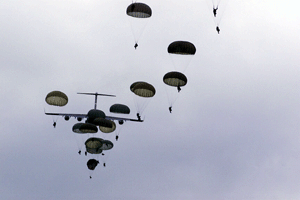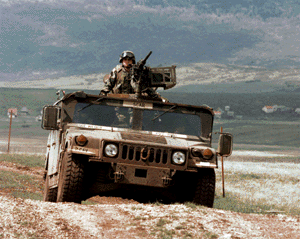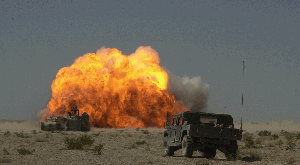Airborne units rely on surprise to quickly seize strategic points with daring assaults in support of major offensives. However, these tactics are of little value in stopping advancing armies. Deploying airborne or even airmobile units to face enemy armored forces is suicidal, but this didn't stop the US military for placing a brigade from the 82nd Airborne in the desert in 1990 to deter several Iraqi armor divisions. Paratroopers jokingly referred to their defensive role as "speed bumps." Despite this event, the US military still has no rapid deployable units equipped and trained to delay large advancing armies.
 Few
US military officers understand
rearguard tactics. They are not discussed in schools and learning "how to retreat"
is rarely
practiced in exercises. This is unfortunate because a rapidly advancing
force is vulnerable to ambush and mines. Many Generals have
adopted the "Patton mentality" of pushing ahead regardless of losses
or dangers to their flanks. Patton was lucky that even the respected German
military rarely trained and equipped units specifically for rearguard tactics.
Few
US military officers understand
rearguard tactics. They are not discussed in schools and learning "how to retreat"
is rarely
practiced in exercises. This is unfortunate because a rapidly advancing
force is vulnerable to ambush and mines. Many Generals have
adopted the "Patton mentality" of pushing ahead regardless of losses
or dangers to their flanks. Patton was lucky that even the respected German
military rarely trained and equipped units specifically for rearguard tactics.
The masters of rearguard action were the Communist Chinese, who slowly exhausted powerful Japanese armies during World War II with their traditional "water" tactic of avoiding an enemy's main punch and flowing around to attack its flanks. The US military encountered similar problems in Vietnam where the weaker enemy refused to stand and fight. Most western military officers do not understand that a fighting retreat is a great tactic. Even fewer understand the tactics involved in gradually destroying an aggressive enemy with rearguard ambushes.
All modern Armies should have highly mobile "Guard" battalions equipped and trained for independent rearguard operations. An enemy force should never be allowed to peacefully advance through the countryside. Even small teams of snipers with a few mines can hamper the advance of a large armored force by pinning down logistical elements. A well-trained Guard battalion mounted on light trucks can prove a formidable opponent for a rapidly advancing Corps. These light units can be dropped by parachute as lead elements of a rapid deployment force, or positioned by helicopter. If this is not practical, they can simply drive forward to engage the enemy. Guard battalions also have a role in offensive operations by guarding extended flanks against surprise enemy counterattacks.
Guard Battalion
A Guard battalion should consist of four companies: Frog, Demolition, Commando, and H&S. Mobility would consist of light trucks like the American HMMWV since fuel economy is important, and motorcycles for commando teams. The entire battalion may be parachute capable, and deploy with enough supplies for a week of combat. This unit is not designed to land in hostile territory, but in the path of an advancing army.
 Frog Company -
with three "frog" platoons
conduct rearguard actions on a main road by leapfrogging each other.
Mounted on light trucks these highly mobile platoons rely on stand-off
weaponry like heavy machine guns and Hellfire missiles to ambush and engage lead
enemy units. All three are supported by a heavy mortar platoon mounted on light
trucks.
Frog Company -
with three "frog" platoons
conduct rearguard actions on a main road by leapfrogging each other.
Mounted on light trucks these highly mobile platoons rely on stand-off
weaponry like heavy machine guns and Hellfire missiles to ambush and engage lead
enemy units. All three are supported by a heavy mortar platoon mounted on light
trucks.
Ground armies are dependent on roads for rapid advancement, which means advancing in column. As a result, they are easily ambushed and must deploy abreast to attack. Each ambush causes several minutes of confusion while the enemy attempts to call in artillery support and evaluate the defender's strength. Frog ambushes take advantage of obstacles and mines placed the Demolition Company. Attackers become demoralized by mines because they must press ahead and suffer loses, or lose hours while engineers sweep ahead.
Attackers suffer delays as they must deploy large units from columns into attack formations to attack Frog platoons. However, the Frog platoon would withdraw before a deployed attack force can fully engage. This tactic is difficult to teach because ambushers may fight too long while enjoying their turkey shoot until the enemy zeros in with far greater firepower. They must ambush for a few of minutes, then run away to fight another day.
 Demolition Company -
is an engineer company
specializing in counter-mobility by using explosives to destroy bridges,
crater roads, create rockslides, and plant mines in support of frog platoon
ambushes. Retreating friendly forces may also
abandon valuable supplies and equipment which Demo teams must destroy. Most
importantly, no fuel will be left behind for the enemy, even civilian gas
stations should be set ablaze.
Demolition Company -
is an engineer company
specializing in counter-mobility by using explosives to destroy bridges,
crater roads, create rockslides, and plant mines in support of frog platoon
ambushes. Retreating friendly forces may also
abandon valuable supplies and equipment which Demo teams must destroy. Most
importantly, no fuel will be left behind for the enemy, even civilian gas
stations should be set ablaze.
Commando Company - consists of twelve squads trained to independently harass enemy rear units along roadways. Commando squads are assigned a section of road where they operate from light trucks, motorcycles, or on foot depending on the terrain. Commandos hide from advancing combat units, then attack trucks of support elements following in trace. Small ambushes, sniping, and road mining are basic missions.
Their goal is to delay and disrupt support units and force advancing enemy forces to post security units along its entire flanks. Resupply and eventual escape is major concern for commando squads. Ideally, supplies can be acquired from the enemy, or perhaps from helicopters. Headquarters must determine the method of withdrawal for commandos. Helicopters are best, but they may need to withdraw on their own before enemy forces can form a continuous front behind them. In a chaotic war, each commando squad will be left to escape on its own once it is no longer combat effective due to a lack of supplies or excessive casualties.
Headquarters and Service Company - is highly mobile group must coordinate the actions of its dispersed elements. It remains far from combat to coordinate leapfrog ambushes along with close air support. A more difficult function is to locate supplies on a chaotic battlefield and move them to forward units. This is urgent since Guard battalions arrive with just a week of supplies and no established supply system. Hopefully, supplies can be airdropped where needed, but helicopters provide more flexibility. Even without resupply, a Guard battalion can stall a major offensive for over a week to allow regular units time to arrive.
Guard Tactics
A Guard battalion can quickly slow an enemy advance and make him frustrated and careless. After a dozen Frog ambushes, he will press ahead without proper reconnaissance. This confidence may prove disastrous when they reach a position defended by regular troops. An attacking battalion may press ahead blindly with no artillery support in pursuit of a Frog platoon, only to find itself in the kill zone of a much larger force.
Coordinating a dispersed Guard battalion is prove difficult. However, each squad and platoon would be trained to operate alone and isolated, a tradition in the Airborne. Their confidence may rally retreating forces to fight alongside them. Just one of these battalions can stall a division-sized attack for several days, and even a Corps size offensive in difficult terrain.
Guard battalions are not only for rapid deployment, but also ideal to hold in reserve to blunt surprise enemy breakthroughs. They can deploy rapidly in theater with the confidence to coordinate effective rearguard defenses among retreating regular forces. This is similar to the successful defense by the 101st Airborne in the "Battle of the Bulge" during World War II, which was not a mobile defense, but an instance where a light unit was rapidly deployed to disrupt an entire offensive. The Korean war provided many occasions where Guard battalions were needed, but not available.
A more recent example was the US Army deployment to Albania in 1999. The deployment took weeks as the Army deployed a heavy force to protect its airfield because of fears that Yugoslav armor may race across the border and through mountains. It would have been far easier to place Guard units in those mountain passes to seal off roads if Yugoslav armor units advanced. Rearguard tactics are not complex, and the lethality of light forces has increased in recent years. Light "Guard" battalions are needed by all large armies.
©2015 www.G2mil.com